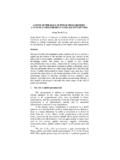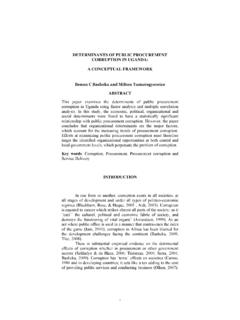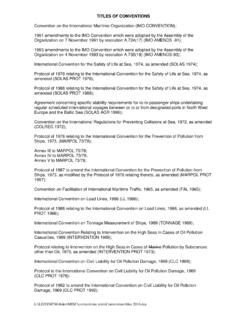Transcription of RISKS MANAGEMENT IN PUBLIC PROCUREMENT FOR …
1 RISKS MANAGEMENT IN PUBLIC PROCUREMENT FOR innovation : THE CASE OF NORDIC- baltic SEA CITIES Tarmo Kalvet and Veiko Lember Tarmo Kalvet, , is a Senior Research Fellow in the field of technology governance at the Department of PUBLIC Administration, Tallinn University of Technology, Estonia. For many years, he was the founding head of the innovation Policy Research Programme at Praxis Centre for Policy Studies, Estonia s leading policy think tank, as well as one of its board members. His recent research interests are innovation policy (especially in small states) and PUBLIC PROCUREMENT for innovation . Veiko Lember, , is a Research Fellow, Department of PUBLIC Administration, Tallinn University of Technology, Estonia. His main research interest is PUBLIC -private partnerships with a particular emphasis on contracting-out PUBLIC services and PUBLIC PROCUREMENT for innovation . Correspondence:Tarmo Kalvet, Department of PUBLIC Administration, Tallinn University of Technology, Akadeemia tee 3, Tallinn 12618, Estonia.
2 E-mail: Abstract State support to innovation in enterprises has a long-standing history. One of the specific support measures is PUBLIC PROCUREMENT for innovation , which has only recently re-emerged in academic discussion as well as in the European policy discourse. While the spillovers from this kind of innovation policy measure may be substantial, the complex processes of supporting innovation via PUBLIC PROCUREMENT involves high RISKS . We take an exploratory approach in determining the state of practice regarding risk MANAGEMENT in PUBLIC PROCUREMENT for innovation on the local level. Five case studies, which were selected as representative cases of the Nordic- baltic Sea region in Europe, were analysed. We found that that the cities were for the most part actively engaged in risk identification; the RISKS are being met mainly with mixed solutions in contracting strategies rather than comprehensive risk- MANAGEMENT tools.
3 2 1. INTRODUCTION State support to innovation to the implementation of a new or significantly improved product (good or service), or process, a new marketing method, or a new organisational method in business practices, workplace organisation or external relations (Organisation for Economic Co-operation and Development & Eurostat, 2005, p. 46; see also Schumpeter, 1934, p. 66) in enterprises has a long-standing history (see, , Reinert, 2007). One of the specific support measures is PUBLIC PROCUREMENT for innovation , sometimes referred to as PUBLIC technology PROCUREMENT (Edquist et al., 2000) or innovation oriented PROCUREMENT (Rothwell, 1984), defined in the current article as that which occurs when a PUBLIC agency acts to purchase, or place an order for, a product service, good or system that does not yet exist, but which could probably be developed within a reasonable period of time, based on additional or new innovative work by the organisation(s) undertaking to produce, supply and sell the product being purchased (see Edquist & Hommen, 2000, p.)
4 5). The United States, along with Japan, China and other Asian countries, has been using PUBLIC PROCUREMENT for promoting innovation since the 19th century (European Commission Working Group [hereafter ECWG], 2006; Ruttan, 2006). The Internet, GPS technology, the semi-conductor industry and passenger jets are perhaps the most prominent examples that resulted from government innovation -oriented PROCUREMENT (Cabral et al., 2006; Ruttan, 2006). The potentially more important role of PUBLIC PROCUREMENT for innovation within the innovation policy mix has recently re-emerged in academic discussion ( Edquist & Hommen, 1999; Edquist et al., 2000; Cabral et al., 2006; Edler & Georghiou, 2007; Rolfstam, 2009; Uyarra & Flanagan, 2010) as well as in the policy discourse ( Kok et al., 2004; Currie, 2005; Edler et al., 2005; Aho et al, 2006; European Commission Expert Group [hereafter ECEG], 2005; ECWG, 2006; Nyiri et al.
5 , 2007; ECEG 2010). We have provided a detailed research framework for including innovation policy in PUBLIC PROCUREMENT at urban level in Lember et al. (2011) and use it as a general framework also for the current study. In short, as innovation in the private sector is increasingly seen as an engine of economic development and competitiveness, it is suggested that PUBLIC PROCUREMENT should be employed to support this process (see also Rothwell, 1984; Geroski, 1990; Edler & Georghiou, 2007). While being an important tool to solve existing as well as emerging social challenges, PUBLIC PROCUREMENT can be used to affect the technology life cycle, promote clusters and innovation systems. PUBLIC PROCUREMENT for innovation can create demand for new products or technologies, enhance providers innovativeness, create 3 and protect infant industry, and thus increase diversification of economic activities and average wages.
6 As urban competitiveness can be viewed as a function of diverse economic activities, higher average wages, increasing returns, positive externalities and a high degree of cooperation, it can be expected that PUBLIC PROCUREMENT for innovation can positively affect these elements. However, unlike in regular PROCUREMENT , where governments place orders for ready-made or off-the-shelf products, PROCUREMENT for innovation involves procuring products that might need additional R&D work and thereby carry additional RISKS to all stakeholders. In the current article we have based ourselves on ECEG (2010) who define risk as the measureable uncertainty (likelihood) for something to happen that decreases the utility of the outcome of an activity or reduces the achievement of certain goals (of an organisation, a project etc.). Accordingly, risk MANAGEMENT in the PUBLIC sector entails having in place a corporate and systematic process for evaluating and addressing the impact of RISKS in a cost effective way and having staff with the appropriate skills to identify and assess the potential for RISKS to arise (National Audit Office, 2000, p.)
7 2). The usual risk- MANAGEMENT tools in PROCUREMENT like screening for abnormally low offers, screening suppliers through insurance schemes and different scoring rules ( closest to the arithmetic average of all submitted offers) may outplay the most innovative offers (Cabral et al., 2006). Sound PUBLIC PROCUREMENT of innovation should therefore involve some kind of risk MANAGEMENT , although it may not necessarily mean that a formal risk MANAGEMENT structure is set up (Chapman & Ward, 2004). There exists evidence that cities are becoming more involved every day in procuring innovative solutions in order to solve existing as well as emerging social challenges ( Pohl & Sandberg, 2005; Edler et al., 2005; Binks, 2006) and increasing their competitiveness (Lember et al., 2011), but what is lacking are theoretical approaches and empirical evidence of how the RISKS are addressed and managed on the local level.
8 The current study was undertaken to fill in the gaps by analyzing the risk- MANAGEMENT aspects of PUBLIC PROCUREMENT for innovation . Therefore, we take an exploratory approach in determining the state of practice regarding risk MANAGEMENT in PUBLIC PROCUREMENT for innovation on the local level. In order to fulfill the research agenda, we analyze five case studies, which were selected as representative cases of the Nordic- baltic Sea region in Europe. The article is built up as follows: the second section of the article analyzes RISKS and risk MANAGEMENT from a theoretical perspective and introduces the method for case studies. The third section describes and analyses five cases of PUBLIC PROCUREMENT for 4 innovation from a risk- MANAGEMENT perspective. The paper ends with a concluding discussion, policy implications and research challenges. 1. METHODS Risk and risk MANAGEMENT Risk results from the direct and indirect adverse consequences of outcomes and events that were not accounted for or that were ill prepared for, and concerns their effects on individuals, firms or society at large.
9 It can result from many reasons both internally induced and occurring externally with their effects felt internally (Kogan & Tapiero, 2007, p. 378). Based on a review of academic literature and case studies carried out, ECEG (2010) has identified five major types of RISKS in the case of PUBLIC PROCUREMENT for innovation . Technological RISKS are all those RISKS that lead to non-completion, under-performance or false performance of the procured service or product for reasons that lie in the technical operation. Technological RISKS could arise from suppliers not being able to find the solutions as promised, choosing the wrong or a suboptimal technology (it does not work as expected or is not fit for purpose, does not match standards, etc), choosing a technology prematurely, failing to acknowledge technological compatibilities or failing to develop the solution in-house or buy components and knowledge as claimed in the tender process.
10 Market RISKS refer to a situation where the private demand does not respond to the extent necessary or expected, PUBLIC markets remain fragmented or there is a lack of companies delivering innovations. The reasons could lie in too radical requirements of the specifications, etc. Organisational RISKS are all those RISKS for the PROCUREMENT to fail or under-deliver for reasons situated within the organisation that procures. Indeed, there tend to be too many goals to follow in modern PUBLIC PROCUREMENT for the PUBLIC administrators cost savings, transparency, sectoral policies ( environmental, energy, industrial etc.) which often contradict each other (Cave & Frinking, 2007; Nyiri et al., 2007). This may lead to misallocation of resources, where agency goals conflict with wider policy goals. There is a dilemma between the micro cost effectiveness of a contract and the higher costs of R&D-based product/services in order to boost innovation (Cabral et al.)

















